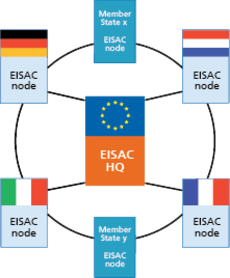VCCC
Virtual centre of competence and expertise in CIPIn accordance with recommendations of the CEPS Task Force on "Critical Infrastructure Protection in the EU" [CEPS11], CIPRNet envisions the creation of a sustainable and distributed Virtual Centre of Competence and expertise in See critical infrastructure protection
[Click for more information]CIP (VCCC). By implementing the CIPRNet agenda and by combining and integrating the excellence in See critical infrastructure protection
[Click for more information]CIP knowledge, expertise, experiences and technology of the partners, CIPRNet will create the tangible VCCC already during the project term. The VCCC serves as the foundation of a long-lasting network of facilities providing enduring support from research to See critical infrastructure
[Click for more information]CI stakeholders in EU Member States. This network of facilities has the working title European Infrastructures Simulation and Analysis Centre
[Click for more information]EISAC (European Infrastructures See computer simulation.
[Click for more information]Simulation and Analysis Centre). A European headquarters shall foster standardisation of technology, organise cross-border collaboration, and provide support at EU level.
A facility like European Infrastructures Simulation and Analysis Centre
[Click for more information]EISAC would contribute to catching up with the leading world-class facilities like NISAC in the US and CIPMA in Australia. Alike NISAC and CIPMA, the VCCC and later European Infrastructures Simulation and Analysis Centre
[Click for more information]EISAC shall emerge bottom-up from collaboration of See critical infrastructure protection
[Click for more information]CIP researchers. Acting as a flywheel with the goal to make the research community more coherent, the VCCC will provide knowledge about See critical infrastructure protection
[Click for more information]CIP research advancements to the See critical infrastructure protection
[Click for more information]CIP multi-person or organization that can affect, be affected by, or perceive themselves to be affected by a decision or activity
[Click for more information]stakeholder community and will support collaborative efforts. In particular, CIPRNet will deploy new services for See critical infrastructure protection
[Click for more information]CIP researchers, end-users and other CIPRNet stakeholders, including comprehensive overviews of state-of-the-art research results (e.g., See critical infrastructure protection
[Click for more information]CIP bibliographies), glossaries, tool repositories, repositories of models, enquiries to experts, and much more, via the CIPRNet/VCCC web portal.
Leveraging on the design study DIESIS
Catching up with NISAC is a long-term endeavour that goes beyond the duration of a Network of Excellence. One of CIPRNet's biggest assets is that Fraunhofer, TNO, and ENEA have already made a first step towards European Infrastructures Simulation and Analysis Centre
[Click for more information]EISAC in the FP7 project Design of an Interoperable European federated Simulation Network for critical Infrastructures
[Click for more information]DIESIS, which gave CIPRNet a head start, reducing the need for an extended NoE duration. The Design of an Interoperable European federated Simulation Network for critical Infrastructures
[Click for more information]DIESIS design study [DIESISw] developed a detailed blueprint for European Infrastructures Simulation and Analysis Centre
[Click for more information]EISAC [DIESISd, DIESISf], which includes:
- A business See conceptual model
[Click for more information]model, including cost and resource estimates and a preparation, deployment and operation plan, - Assessments of legal aspects including suitable legal forms for a self-sustaining distributed European Infrastructures Simulation and Analysis Centre
[Click for more information]EISAC organisation, and - Identification of end-user groups, the descriptions of targeted services and identification of benefits for end-user groups.
The results of the design study will be used for developing and implementing the VCCC. CIPRNet 'kernel of integration' partners (Fraunhofer, TNO, ENEA, CEA) will be the main drivers of the VCCC, each one will have the combined inventory for providing the new capabilities installed at its location. Efforts for making the VCCC sustainable and for developing it further into European Infrastructures Simulation and Analysis Centre
[Click for more information]EISAC comprise the following measures.
References
- [CEPS11] Hämmerli, B.M., Renda, A.: Protecting Critical Infrastructure in the EU, CEPS Task Force Report, Centre for European Policy Studies, Brussels, March 2011
- [DIESISd] Rome, E., Ruzzante, S., Görbil, G., Luiijf, E., Design study of a European The Research Infrastructures part of the FP7 Capacities Programme supports an innovative way of conducting scientific research (referred to as e-Science) by the creation of a new environment for academic and industrial research in which virtual..
[Click for more information]e-Infrastructure for See critical infrastructure protection
[Click for more information]CIP research, Design of an Interoperable European federated Simulation Network for critical Infrastructures
[Click for more information]DIESIS project deliverable D5.3, April 2010 - [DIESISf] DIESIS Final Report, 2010
- [DIESISw] Design of an Interoperable European federated Simulation Network for critical Infrastructures
[Click for more information]DIESIS web site: http://www.diesis-project.eu



